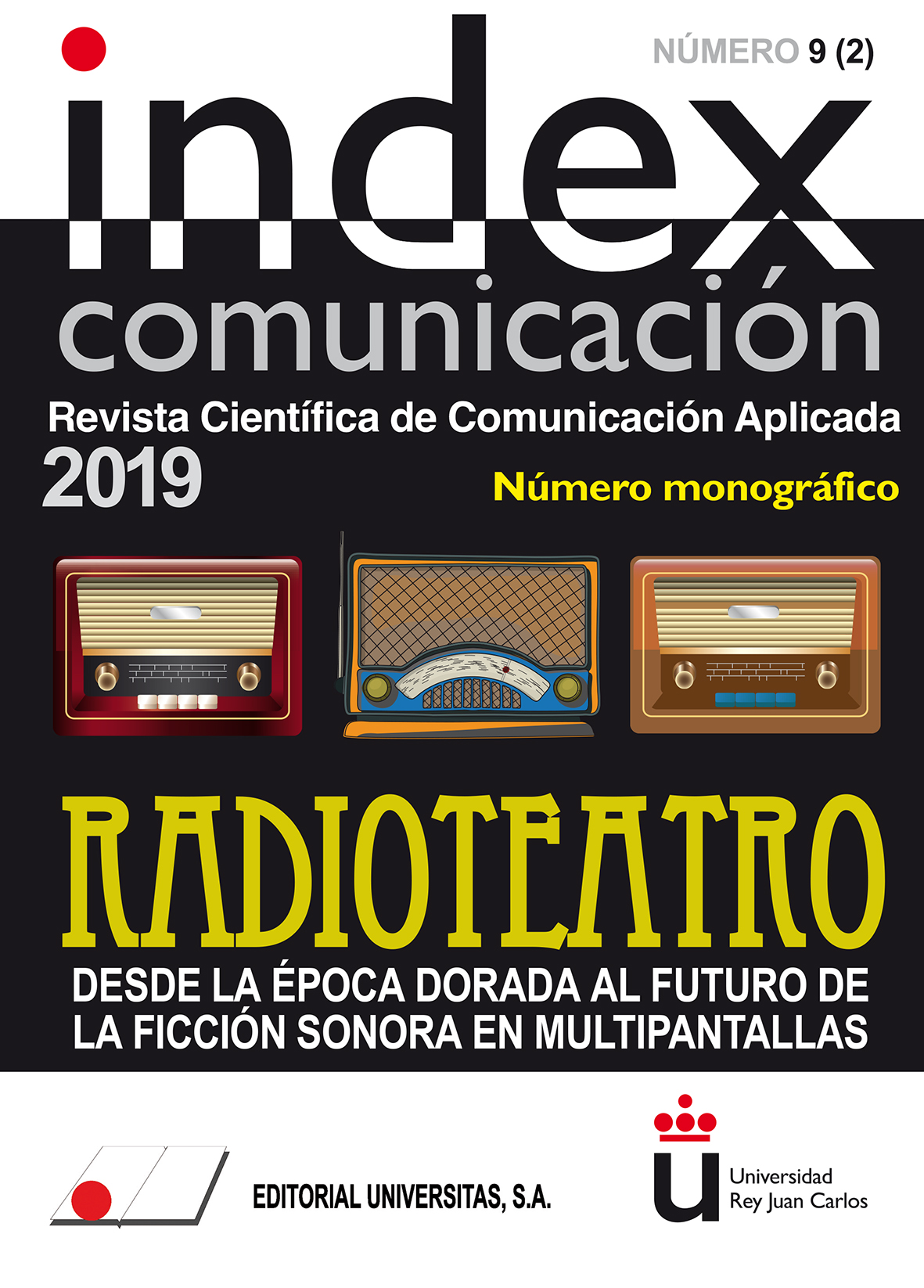Three Stages of Radio Drama in Chile: from the Golden Age to the New Rise of Fiction Series
DOI:
https://doi.org/10.33732/ixc/09/02LastreKeywords:
Radio Drama, Fiction, History, Chile, Podcast,Abstract
Following the growth, since 2016, of new fiction and non-fiction sound series in a large part of Ibero America, thanks to podcast and radio on demand, the task of analyzing the history of radio theater as a genre in Chile, from its roots and sociocultural importance to the new ways of producing and thinking about the genre in the 21st century is conducted. On the basis of documentary information, consisting of press archives, audios of radio theater scripts and the few studies on radio and radio theater, three stages can be elucidated: the golden age (1940-1970); the rebirth of radio theater (2003-2015) and the genre current boom period (2016 to present). While there are certain continuities between the first and second period, despite the temporary and technological breakthrough, in the third stage there is a new way of creating and designing these productions, with plots that respond to social and political struggles of groups that are invisible or discriminated in the public space, as well as in the way of circulating and disseminating them, without the radio being the key place par excellence for transmission as happened with the old radio soap operas.Metrics
References
AYUSO, E. (2013). La recepción de la radio dramática en España (desde la posguerra a 1971). index.comunicación, 3(1), 167-185.
BARBERO, J. M. (2003). De los medios a las mediaciones. Bogotá, Colombia: Editorial Gustavo Gili.
Consejo Nacional de la Cultura y las Artes (2017). Encuesta Nacional de Participación Cultural. Gobierno de Chile. Recuperado desde: https://www.cultura.gob.cl/wp-content/uploads/2018/03/enpc_2017.pdf
CORREA, M. P. (2015). Serie radial. Sonidos de la memoria: la época del radioteatro en Chile. Memoria para optar al título de Periodista. Instituto de la Comunicación e Imagen, Universidad de Chile, Santiago.
El Desconcierto (9 de junio de 2017). El mágico radioteatro que rescata la historia profunda de Aysén y la Patagonia. Recuperado desde: https://www.eldesconcierto.cl/2017/06/09/audio-el-magico-radioteatro-que-rescata-la-historia-profunda-de-aysen-y-la-patagonia/
El Mercurio (22 de mayo de 2003). A última hora se salvó radioteatro. Recuperado desde:
http://www.mercuriovalpo.cl/site/edic/20030521202639/pags/20030521210809.html
FIGUEROA, S. y LARRAÍN, J. (2017). Espérame en el cielo, corazón: El melodrama en la escena chilena de los siglos XX-XXI. Santiago, Chile: Editorial cuarto propio.
GODINEZ, F. (2013). El radiodrama en la comunicación de mensajes sociales. Buenos Aires, Argentina: Jinete insomne.
GODINEZ, F. (2015). Revisitando el radiodrama en la actualidad. Comunicación y Medios, 31, 1-17. Doi: https://doi.org/10.5354/0719-1529.2015.35769
HERNÁNDEZ-SAMPIERI, R. y MENDOZA, C. (2018). Metodología de la investigación. Las rutas cuantitativa, cualitativa y mixta. México D. F., México: Editorial Mc Graw Hill Education.
KISCHINHEVSKY, M. (coord.) (2017). A consolidação dos estudos de rádio e mídia sonora no século XXI. Chaves conceituais e objetos de pesquisa. Intercom-RBCC, 40(3), 91-108. Doi: https://doi.org/10.1590/1809-5844201736
La Nación (1944). Alarma Provocó la Adaptación Radial de la Novela de Wells (13 de noviembre de 1944).
Las Últimas Noticias (22 de mayo de 2003). Entretelones del radioteatro sobre Prat que conmovió a Chile. Las Últimas Noticias,1.
Mapuexpress (8 de febrero de 2018). Escucha el radioteatro Tripulantes Del Sonido, narrativas sonoras. Mapuexpress. Recuperado desde: http://www.mapuexpress.org/?p=23344
MARTÍNEZ-COSTA, M. P. (2010). Información Radiofónica. Madrid, España: Editorial Ariel
MERAYO, A. (2007). La radio en Iberoamérica: evolución, diagnóstico, prospectiva. Sevilla, España: Comunicación Social Ediciones y Publicaciones.
ORTIZ, M. A. y VOLPINI, F. (2017). Realización, lenguaje y elecciones narrativas de radioteatro: tres aproximaciones a la creación de espacios sonoros en el tiempo. Revista de comunicación audiovisual y publicitaria, 17(1). Recuperado desde: http://revistas.ucm.es/index.php/ARAB/article/view/53496
Plaza Pública Cadem (2017). Encuesta Plaza Pública Cadem, nº 223. Recuperado desde: https://plazapublica.cl/encuestas/plaza-publica-cadem-estudio-n223/
PRADENAS, L. (2006). Teatro en Chile: huellas y trayectorias, siglos XVI-XX. Santiago, Chile: Editorial LOM.
RODRÍGUEZ, R. y MATUS DE LA PARRA, P. (2012). Proyecto Cuéntame abuela. Radioteatros con Adultos Mayores. En I Congreso Comunicación y Educación. Segovia: Universidad de Valladolid.
RODRÍGUEZ, R. (2014). Radioteatro como herramienta educativa para rescatar y transmitir patrimonio inmaterial. Cuadernos.Info, 35, 29-38. Recuperado desde: https://doi.org/10.7764/cdi.35.664
SAGREDO, R. y GAZMURI, C. (2010). Historia de la vida privada en Chile 3: El Chile contemporáneo. De 1925 a nuestros días. Santiago, Chile: Taurus.
TENORIO, I. (2012). La nueva radio: manual completo del radiofonista 2.0. Barcelona, España: Marcombo.
VALLE, F. (30 de octubre de 2013). A 75 años del hito de Welles: Valparaíso se convierte en escenario de una nueva Guerra de los Mundos. Radio Bío Bío. Recuperado desde:
Published
How to Cite
Issue
Section
License
Copyright (c) 2019 Raúl Rodríguez Ortiz

This work is licensed under a Creative Commons Attribution-NonCommercial 4.0 International License.
Authors who submit to this journal agree to the following terms:
Authors retain copyright and ensure the magazine's right to be the first publication of the work as licensed under a Creative Commons Attribution-NoComercial 4.0 International License that allows others to share the work with an acknowledgment of authorship of the work and the initial publication in this magazine, with no commercial purpose.
Authors can establish separate additional agreements for non-exclusive distribution of the version of the work published in the magazine (for example, to an institutional repository or publish it in a book), with an acknowledgment of its initial publication in this journal.
It allows and authors are encouraged to disseminate their work electronically (eg, in institutional repositories or on their own website) prior to and during the submission process, as it can lead to productive exchanges, as well as a citation more early and most of the published work (See The Effect of Open Access).















